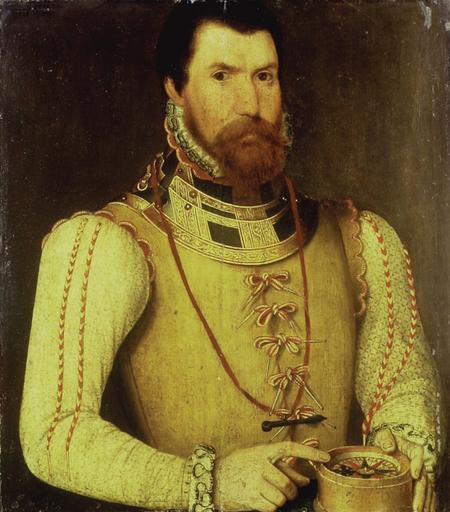MAKE A MEME
View Large Image

| View Original: | Edward_Fiennes_de_Clinton,_1st_Earl_of_Lincoln.jpg (563x640) | |||
| Download: | Original | Medium | Small | Thumb |
| Courtesy of: | www.flickr.com | More Like This | ||
| Keywords: people indoor Edward Fiennes de Clinton, 1st Earl of Lincoln (1512 – 16 January 1584/85) was an English admiral during the 16th century. Born in Scrivelsby in Lincolnshire in 1512 to Thomas Clinton, 8th Baron Clinton and Mary Clinton, Baroness Clinton (née Poynings), the then Lord Clinton joined the retinue of King Henry VIII at Boulogne and Calais in 1532. Serving in the Parliament of 1536 he later served in the Royal Navy against French and Scottish naval forces from 1544 to 1547. Knighted in Edinburgh by Edward Seymour, 1st Earl of Hertford, (later 1st Duke of Somerset) for his role in the capture of the city in 1544 he also took part in the siege of Boulogne in 14 September 1544. Under John Dudley, 2nd Earl of Warwick he saw action against the French at the Battle of Spearhead in 1545 and was sent as one of the peace commissioners to France the following year. Commanding the English fleet during the invasion of Scotland by Edward Seymour he provided naval artillery support at the Battle of Pinkie on 15 September 1547. Appointed Governor of Boulogne in 1547, he successfully defended the city against a French siege from 1549 to 1550. That same year, with Henry Manners, 2nd Earl of Rutland, he became the Lord Lieutenant of Lincolnshire and Nottinghamshire as well as serving as Lord High Admiral under King Edward VI from 1550 to 1554, and again from 1559 to 1585, and as Privy Counsellor from 1550 to 1553, briefly serving as an envoy to France in 1551. After becoming the Lord-Lieutenant of Lincolnshire in 1552, Clinton later took part in the defeat of Wyatt's Rebellion in Kent in 1554. Becoming Lord General of Earl Pembroke's expedition he fought with Spanish forces at the Battle of Saint-Quentin on 10 August 1557. Upon his return to England, Clinton took command of the English fleet and began raiding the French coast burning the town on Conquet and the surrounding area in 1558. A joint commander with Ambrose Dudley, 3rd Earl of Warwick of a large army during the Northern Rebellion however the army was still being assembled when the rebellion was defeated in January 1570. He was created Earl of Lincoln in 1572, and served as ambassador to France, undertaking several commissions from Queen Elizabeth I until his death in London on 16 January 1585. He married three times. His first, to Elizabeth Blount, Henry VIII's former mistress, produced three daughters; his second to Ursula Stourton produced six children, including his heir, Henry Clinton, 2nd Earl of Lincoln. His third wife was Elizabeth FitzGerald, daughter of Gerald FitzGerald, 9th Earl of Kildare, whom he married on 1 October 1552. Their marriage was childless. Edward Fiennes de Clinton, 1st Earl of Lincoln (1512 – 16 January 1584/85) was an English admiral during the 16th century. Born in Scrivelsby in Lincolnshire in 1512 to Thomas Clinton, 8th Baron Clinton and Mary Clinton, Baroness Clinton (née Poynings), the then Lord Clinton joined the retinue of King Henry VIII at Boulogne and Calais in 1532. Serving in the Parliament of 1536 he later served in the Royal Navy against French and Scottish naval forces from 1544 to 1547. Knighted in Edinburgh by Edward Seymour, 1st Earl of Hertford, (later 1st Duke of Somerset) for his role in the capture of the city in 1544 he also took part in the siege of Boulogne in 14 September 1544. Under John Dudley, 2nd Earl of Warwick he saw action against the French at the Battle of Spearhead in 1545 and was sent as one of the peace commissioners to France the following year. Commanding the English fleet during the invasion of Scotland by Edward Seymour he provided naval artillery support at the Battle of Pinkie on 15 September 1547. Appointed Governor of Boulogne in 1547, he successfully defended the city against a French siege from 1549 to 1550. That same year, with Henry Manners, 2nd Earl of Rutland, he became the Lord Lieutenant of Lincolnshire and Nottinghamshire as well as serving as Lord High Admiral under King Edward VI from 1550 to 1554, and again from 1559 to 1585, and as Privy Counsellor from 1550 to 1553, briefly serving as an envoy to France in 1551. After becoming the Lord-Lieutenant of Lincolnshire in 1552, Clinton later took part in the defeat of Wyatt's Rebellion in Kent in 1554. Becoming Lord General of Earl Pembroke's expedition he fought with Spanish forces at the Battle of Saint-Quentin on 10 August 1557. Upon his return to England, Clinton took command of the English fleet and began raiding the French coast burning the town on Conquet and the surrounding area in 1558. A joint commander with Ambrose Dudley, 3rd Earl of Warwick of a large army during the Northern Rebellion however the army was still being assembled when the rebellion was defeated in January 1570. He was created Earl of Lincoln in 1572, and served as ambassador to France, undertaking several commissions from Queen Elizabeth I until his death in London on 16 January 1585. He married three times. His first, to Elizabeth Blount, Henry VIII's former mistress, produced three daughters; his second to Ursula Stourton produced six children, including his heir, Henry Clinton, 2nd Earl of Lincoln. His third wife was Elizabeth FitzGerald, daughter of Gerald FitzGerald, 9th Earl of Kildare, whom he married on 1 October 1552. Their marriage was childless. | ||||